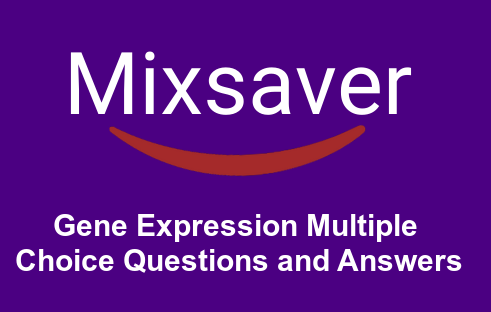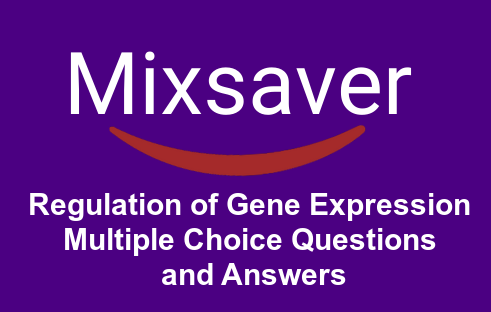Gene Expression Quiz | Gene Expression Questions and Answers pdf
1. Sigma factor is a component of
(a) DNA ligase
(b) DNA polymerase
(c) RNA polymerase
(d) Dissociation factor
Ans. c
2. RNA polymerase
(a) is the protein responsible for the production of ribonucleotides
(b) is the enzyme that creates hydrogen bonds between nucleotides on the DNA template strand and their complementary RNA nucleotides
(c) is the enzyme that transcribes exons but does not transcribe introns
(d) begins transcription at a promoter sequence and moves along the template strand of DNA, elongating the RNA molecule in a 5′ 3′ direction
Ans. d
3. Transcription involves the transfer of information from
(a) DNA to RNA
(b) RNA to DNA
(c) MRNA to an amino acid sequence
(d) the nucleus to the cytoplasm
Ans. a
4. Which of the following is true for RNA processing?
(a) Exons are excised before the MRNA is translated
(b) Assemblies of protein and snRNPs, called spliceosomes, may catalyse splicing
(c) The RNA transcript that leaves the nucleus may be much longer than the original transcript
(d) All of the above
Ans. d
5. The strongest evidence that DNA is the genetic material comes from the
(a) fact that the chromosomes are made of DNA
(b) studies on the transformation of bacterial cells
(c) knowledge that the DNA is present in the nucleus
(d) findings that the DNA is not present in the cytoplasm
Ans. b
6. Initiation of polypeptide chain in protein synthesis is induced by
(a) methionine
(b) leucine
(c) lysine
(d) glycine
Ans. a
7. UAA, UAG and UGA are known as non-sense codons because they
(a) code for amino acids, which are not essential amino acids
(b) code for the initiator amino acid (methionine), which is later removed from the polypeptide chain
(c) are never present on MRNA
(d) do not code for any amino acid
Ans. d
8. Gene is
(a) a segment of DNA
(b) a segment of DNA and histone
(c) a segment of DNA, RNA and histone
(d) All of the above
Ans. a
MCQ on Regulation of Gene Expression in Eukaryotes
9. The first translated codon in any mRNA binds to an anticodon is
(a) 3′ UAC 5′
(b) 5’UAC 3′
(c) 3′ UAU 5′
(d) 5’CAU 3′
Ans. b
10. The minimum length of cistron in base pair, which synthesises a polypeptide of 50 amino acids is
(a) 50 bp
(b) 100 bp
(c) 150 bp
(d) 200 bp
Ans. c
11. Translocation involves
(a) the movement of the ribosome in the P-site to the A-site
(b) the movement of the MRNA štrand one triplet length in the A-site
(c) the release of the unattached tRNA from the E-site
(d) All of the above
Ans. a
12. If the sequence of bases in DNA is ATTCGATG, then the sequence of bases in its transcript will be
(a) GUAGCUUA
(b) UAAGCUAC
(c) CAUCGAAU
(d) AUUCGAUG
Ans. b
13. The direction of synthesis of DNA, RNA and protein are always
(a) 3’5
(b) 5’3
(c) Both (a) and (b)
(d) None ot these
Ans. b
14. Experiments using N5 (heavy nitrogen) to confirm the semiconservative replication of DNA were carried out by
(a) Meselson and Stahl
(b) Hershey and Chase
(c) Beadle and Tatum
(d) Watson and Crick
Ans. a
DNA Sequencing MCQs | MCQs on DNA Sequencing
15. Regulatory genes are the genes that
(a) code for repressor proteins
(b) are transcribed continuously
(c) are not contained in the operon they control
(d) All of the above
Ans. a
16. Which one of the following pairs is correctly matched?
(a) Fredrick Griffith – Discovered the phenomenon of transformation
(b) Linus Pauling – Isolated DNA tor the first time
(c) Francis Crick – Proposed one gene-one polypeptide hypothesis
(d) George Beadle – Proposed the concept of inborn errors
Ans. a
17. Genetic code translated the language of
(a) RNA into that of proteins
(b) proteins into that of RNA
(c) amino acids into that of RNA
(d) RNA into that of DNA
Ans. a
18. A gene is made up of
(a) DNA
(b) RNA
(c) either DNA or RNA
(d) amino acids
Ans. a
19. The growing polypeptide chain is released from the ribosomes when
(a) a chain terminating codon is reached
(b) a chain terminating tRNA binds to the ribosome
(c) the 7 methyl guanosine cap is reached
(d) the poly A tail is reached
Ans. a
20. The peptidyl transferase reaction occurs
(a) on the large subunit
(b) on the small subunit
(c) between the subunit
(d) None of these
Ans. a
21. The pathway of a tRNA during polypeptide elongation on the ribosome is –
(a) A- site – P site — Exit – site
(b) A – site – P site — Entry – site
(c) P- site – A – site — E – site
(d) P-site – Entry – site — Exit – site
Ans. a
22. How many energy bonds are expended in the formation of a peptide bond?
(a) 3
(b) 4
(c) 2
(d) 6
Ans. b
23. An antibiotic which inhibits translation in both prokaryotes and eukaryotes is
(a) tetracycline
(b) actinomycin -D
(c) chloromycetin
(d) puromycin
Ans. d
24. The core enzyme constituting the E. coli RNA polymerase consists of following subunits
(a) β, β’, a, w
(b) β, β’, σ, a
(c) β, β, σ, w
(d) β, σ, a, w
Ans. d
25. Which of the following will be translated into a protein?
(a) UAA AUG CCC TCC CAT TATG
(b) AUG CCC UCU AUA GUA GTC
(c) UAA CCC UCU AUA GUA GUC
(d) AUG CCC UCU AUG GUC UAG
Ans. d
26. Gene controls
(a) protein synthesis and heredity
(b) protein synthesis but not heredity
(c) biochemical reactions of some enzymes
(d) heredity but not protein
Ans. a
27. RNA polymerase is capable of catalysing
(a) initiation
(b) elongation
(c) termination
(d) All of these
Ans. b
MCQ on Genomic Library
28. MRNA is also known as
(a) information RNA
(b) termplate RNA
(c) messenger RNA
(d) All of these
Ans. d
29. The RNA constituting about 70-80% of the total RNA is
(a) ribosomal RNA
(b) messenger RNA
(c) transfer RNA
(d) template RNA
Ans. a
30. RNA attaches amino acids at its
(a) 3-end
(b) 5′-end
(c) anticodon
(d) loop
Ans. a
31. Jumping genes’ that have the ability to move within and between chromosomes are called
(a) introns
(b) oncogenes
(c) transposons
(d) retroviruses
Ans. c
MCQ on DNA Sequencing with Answers
32. In transcriptional control in eukaryotic cells
(a) a different combination of DNA binding proteins (transcriptional tactors) may regulate the activity of a particular gene
(b) enhancers may be involved in the promotion as well as regulation of gene transcription
(c) may be due to the phosphorylation of transcriptional factors by a kinase
(d) All of the choices are correct
Ans. d
33. Transcription takes place in
(a) matrix
(b) cytosol
(c) nucleus
(d) cytoplasm
Ans. c
34. DNA polymerase III is thought to add nucleotides
(a) to the 5′-end of the RNA primer
(b) to the 3-end of the RNA primer
(c) in the place of the primer RNA after it is removed
(d) on single stranded templates without need for an RNA primer
Ans. b
35. The sequence of one strand of DNA is 5′ TCGATC3. The sequence of the complementary strand would be
(a) 3′ AGCTAG 5′
(b) 5′ TCGATC 3′
(c) 5’CTAGCT 3
(d) 5′ GCTAGC 3
Ans. a
36. The RNA polymerase that produces the primer necessary for DNA synthesis is called the
(a) origin of replication
(b) convertase
(c) primase
(d) ligase
Ans. c
37. DNA replication in vivo is discontinuous due to
(a) polymerase slippage
(b) trinucleotide repeats
(c) being restricted to synthesis in the 5′ 3′ directio
(d) topoisomerases cutting the DNA in a random fasho
Ans. c
38. Which enzyme that catalyzes the formation covalent bond between adjacent 5′-P and 3-OH termini of separate fragments of DNA?
(a) Origin of replication
(b) Convertase
(c) Primase
(d) Ligase
Ans. d
39. The process of producing a RNA polymer from a DNA template is called
(a) replication
(b) transcription
(c) translation
(d) duplication
Ans. b
40. Which of the following features is common to both DNA replication and transcription?
(a) Nucieotides are added to the 5′-end of the newly synthesised strand.
(b) A sugar-phosphate bond is formed between the 3-OH and the 5′-phosphate.
(c) Deoxyribonucleotides are incorporated into the growing sequence
(d) Both RNA and DNA polymerase require oligonucleotide priming
(e) Both RNA and DNA polymerase initiate at promote sequences
Ans. a





